
This picture is a photograph of an eggplant that is growing in one of our two raised garden beds. The eggplant variety is Lavender Touch. I selected this variety because the fruit looks so different from a typical eggplant.
I planted three eggplants as transplants in our garden on July 4. I have been watering them every few days and fertilizing them with water soluble fertilizer once a week.
I was a bit skeptical that these eggplants would produce fruit, because they were planted so late. I have never grown eggplant before this year, and I am thrilled at how easy they are to grow. They have grown substantially, especially in the last few weeks, and they are producing fruit. They seem to be thriving in the hot weather we have been experiencing. The high temperatures here have been mostly in the 90s for the past two weeks.
I have read that, in our climate, many warm weather annual fruits and vegetables can be planted from early spring through early summer, including beans, corn, and squash. I am thinking about spacing out my plantings of some annual fruits and vegetables next year. Perhaps if some transplants are set in the ground in March, some in May and some in July, I can have harvests over a longer season.
Eggplants and peppers seem to require several months of warm weather. Gardening publications typically recommend setting eggplant and pepper transplants in the ground in mid-to-late spring. However, my experience shows that eggplants planted in early summer can produce fruit, at least in our climate.
September 06 2008 | Eggplant | Comments Off on Lavendar Touch Eggplant
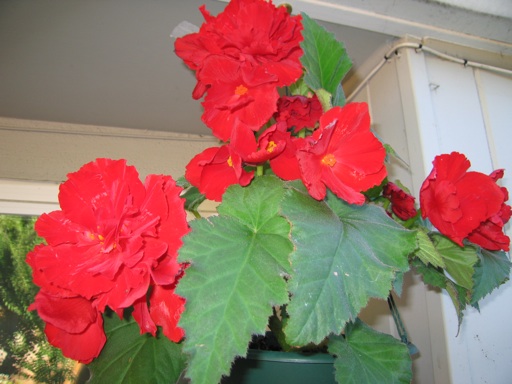
I have not had any luck growing begonias in the ground. Snails always devour nearly every portion of the plant. I have the same problem with dahlias. Snails consume the leaves so quickly as they grow above the ground that the tuber does not have a chance to develop a stem.
A few months ago, I purchased the above-pictured full-grown begonia from a nursery and planted it in a hanging container. I figured the snails were unlikely to get to it here. So far, I have not noticed any holes in the leaves. It continues to bloom and look great.
August 31 2008 | Begonia | Comments Off on Red Begonia

This is a picture of a peaches and cream brugmansia we are growing. I planted it about 3 years ago. It grew well for about a year and half, and it bloomed spectacularly on at least one occasion.
In January 2007, it froze to the ground during cold weather. Since then, it has slowly been making a come back. A few days ago, it started blooming for the first time since the freeze.
I really like this brugmansia, because of its peachy colored flowers and variegated leaves. It does not grow as fast or bloom as much as the Charles Grimaldi brugmansia. Even so, it makes an attractive small shrub.
I put copper tape around the base of the trunk to keep the snails from eating the leaves. Without some form of snail control, snails eat many holes in the leaves, making the plant look unattractive.
I water this brugmansia regularly. I have it growing in a spot that only receives filtered sunlight in the afternoon and mostly shade in the morning. Although many sources say to plant brugmansia in full sun, my experience has been that brugmansia wilts frequently in full sun on hot summer days. I tend to think a shady or partly sunny spot is more ideal for brugmansia.
August 31 2008 | Brugmansia | Comments Off on Peaches and Cream Brugmansia
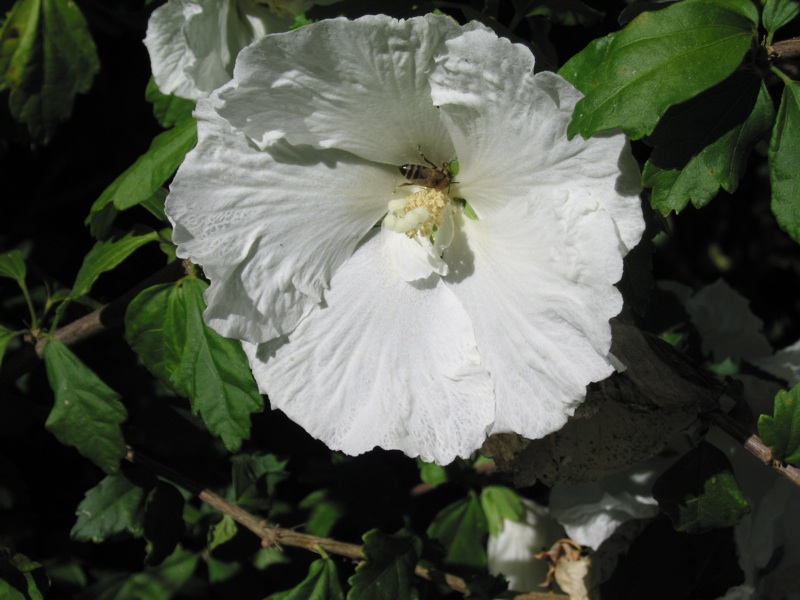
The above-pictured white rose of sharon has been blooming in our backyard for over a month. Every time I go outside to look at it, bees are buzzing around its flowers. I have not noticed a decline in the bee population in our backyard.
Apparently, certain flowers attract bees more than others. Rose of sharon appears to be very attractive to bees. My guess is that growing a diversity of flowering plants is probably good for prompting a healthy local honey bee population. Most flowering plants only bloom for a few weeks out of the year. Growing a diversity of flowers gives bees a food source over a longer season.
This rose of sharon bush was planted by the previous owners. Its flowers are attractive, and it has bloomed every summer. Also, it requires very little care. I don’t think I have ever fertilized it, and it doesn’t seem to require a lot of water. Rose of sharon is also very frost tolerant. It can easily withstand temperatures in the 20s, and probably much lower.
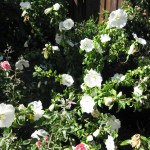
August 29 2008 | Rose of Sharon | Comments Off on White Rose of Sharon
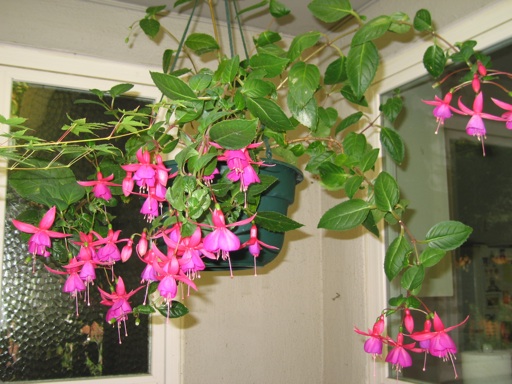
It seems that a garden is not complete without at least one plant in a hanging container. Fuchsias are one of the best suited plants to grow in hanging containers. Growing them in hanging containers makes it easier to view them. One can just look up and view the flowers as they droop downward.
Some varieties of fuchsias have erect branches and others having drooping branches. I think that the types of fuchsias with drooping branches look especially attractive in a hanging basket.
These are pictures of fuchsias that are blooming outside our kitchen window right now.
Fuchsias are frost sensitive plants. They should be brought inside during freezing weather in the winter if they are being grown as perennials. We bought the above-pictured fuchsia in 2007. It survived the entire winter of 2007-2008 outside without being brought inside. The temperatures here did not dip too far below freezing last winter. This fuchsia is now in its second summer.
The below-pictured fuchsia was purchased from a nursery last spring, looking nearly like what it does now. It looked great for weeks until it stopped blooming. But I managed to get it to bloom again. The secret, I have learned, to getting our fuchsias to bloom multiple times each year is repeated applications of fertilizer. I apply water soluble fertilize to them about once every two weeks. The fertilizer seems to kick start another bloom a few weeks after the last one has finished. Now I am wondering whether I can keep repeat blooms going through autumn this year.
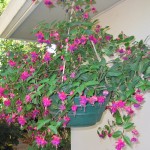
August 26 2008 | Fuchsia | Comments Off on Hanging Fuchsias
« Prev - Next »






